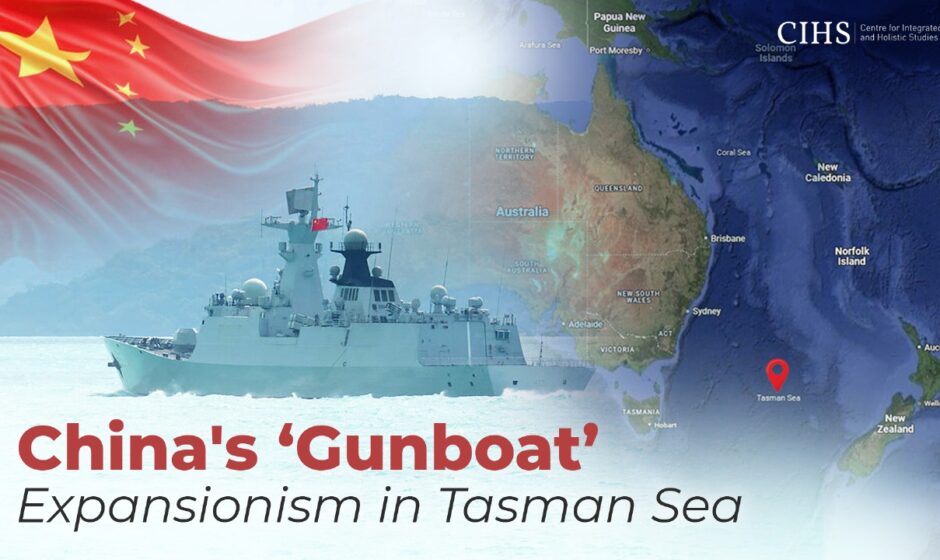PLA Navy seeks to expand Chinese Communist control beyond traditional Indo-Pacific areas and change power dynamics vis-à-vis Australia, New Zealand and their Western allies.
Ayadoure Stalin
China’s recent naval activities in Tasman Sea have caught the attention of many across Indo-Pacific. This unusual move by People’s Liberation Army (PLA) marks a significant display of naval strength, indicating Beijing’s strategic aim to disrupt current balance of power in the region.

Considering Tasman Sea’s closeness to Australia and New Zealand countries that have traditionally held sway in South Pacific China’s actions imply a broader geopolitical strategy that could alter security landscape in the area.
Tasman Sea has traditionally remained outside China’s naval exercises domain making this recent manoeuvre an unusual and deliberate display of force. PLA Navy’s growing presence in these waters marks a departure from its conventional areas of military operations, primarily concentrated in South China Sea, East China Sea and Taiwan Straits.
This geographic shift indicates Beijing’s desire to expand its operational reach into broader Indo-Pacific, demonstrating its ability to project power beyond its immediate maritime periphery which in itself is controversial and expansionist.
China’s decision to operate in this region should not be viewed in isolation but as part of its broader maritime strategy which seeks to counter Western presence in the Pacific.
While official Chinese statements may downplay significance of these drills, the message to Australia, New Zealand and their allies is apparent: China will assert its presence in waters traditionally dominated by Western powers.
Western presence in South Pacific
Tasman Sea has typically been outside the realm of China’s naval exercises, making this recent manoeuvre a notable and intentional show of strength. PLA Navy’s increasing activity in these waters departs from its usual military operations which are mainly focused on South China Sea, East China Sea, and Taiwan Straits.
This shift suggests that Beijing aims to expand its operational reach into wider Indo-Pacific showcasing ‘communist military strength’ beyond its immediate accepted maritime boundaries.
China’s choice to engage in this region should be considered part of its larger maritime strategy which aims to counter Western influence in the Pacific. Although official Chinese statements may downplay the importance of these drills, the message to Australia, New Zealand, and their allies is clear: China is prepared and capable of asserting its presence in waters that have traditionally been under Western control.
Provocative Display of Power
China’s naval expansion in Tasman Sea is more expansionist as part of a larger plan of President Xi Jingping to alter regional security landscape. Deployment of Chinese warships in this unexpected area goes beyond a simple military exercise; it represents a calculated display of power that fulfils several strategic goals. Firstly, it tests responses of Australia and New Zealand assessing their speed and effectiveness in addressing perceived threats nearby. This gives China insight into Western regional allies’ military readiness and strategic collaboration.
Secondly, it conveys a strong message to smaller Pacific nations that China was the ‘big brother’ capable of wielding diplomatic and military influence in their waters.
China’s activities in Tasman Sea might not be limited to mere displays of strength. Violation of territorial waters treaties, coercive actions and other aggressive manoeuvres cannot be ignored. Given China’s history of using its naval power for intimidation such as island-building in the South China Sea or conducting military drills near Taiwan these concerns are valid.
Shadow of Gunboat Diplomacy
China’s naval activities in Tasman Sea reflect its Gunboat Diplomacy, a tactic historically used by it to exert influence through naval presence. This strategy has been apparent in Beijing’s approach to territorial disputes in South China Sea, its assertive stance in Taiwan Straits and its growing resistance to US Pacific Command operations.
China aims to bolster its claims over Indo Pacific waters by employing Gunboat Diplomacy, intimidate rivals and deter outside interventions. Deployment of PLA Navy assets in Tasman Sea extends this strategy, signalling Australia, New Zealand and their allies that western powers may not be able to negate China’s influence in wider Indo-Pacific region.
China is contesting supremacy of US Pacific Command. Historically, Washington has maintained a robust naval presence in Indo-Pacific to counterbalance China’s expanding military reach. However, Beijing’s ability to conduct operations far from its shores indicates a growing desire to quickly expand its arc of influence thereby challenge U.S.-led regional security frameworks.
Implications for the Indo-Pacific
PLA presence in Tasman Sea raises important questions about the future of regional security and strategic balance in the Indo-Pacific. Australia, New Zealand and their allies will likely see China’s actions as a wake-up call, leading to discussions on effectively counterbalancing Beijing’s increasing military assertiveness.
Several potential responses could arise: First, strengthening regional alliances Australia and New Zealand may look to enhance their defence cooperation with like-minded partners including US, Japan, and India through frameworks like Quad and AUKUS.
Secondly, enhancing maritime surveillance both nations might prioritize increased investments in maritime domain awareness capabilities to monitor Chinese naval activities better.
Thirdly, diplomatic pushback Canberra and Wellington could use diplomatic channels to garner support from Pacific island nations, ensuring they do not fall under China’s influence.
Fourthly, increased military preparedness expect to see greater defence spending and military exercises aimed at showcasing regional resolve against possible Chinese encroachments.
China’s recent activities inTasman Sea are not likely to be a one-off event. Instead, they indicate a more significant shift in Beijing’s military strategy one aimed at challenging the current security framework in the South Pacific.
Through economic pressure, diplomatic initiatives and increased naval presence, China is gradually working to reshape the Indo-Pacific to its advantage.
China’s PLA navy operations in Tasman Sea represent a notable shift from its usual military focus indicating a bold move into waters traditionally under Western control.
(Author is an UGC Junior Research Fellow at Centre for Indo Pacific Studies, School of International Studies, Jawaharlal Nehru University, New Delhi)China Extends to Tasman Sea



